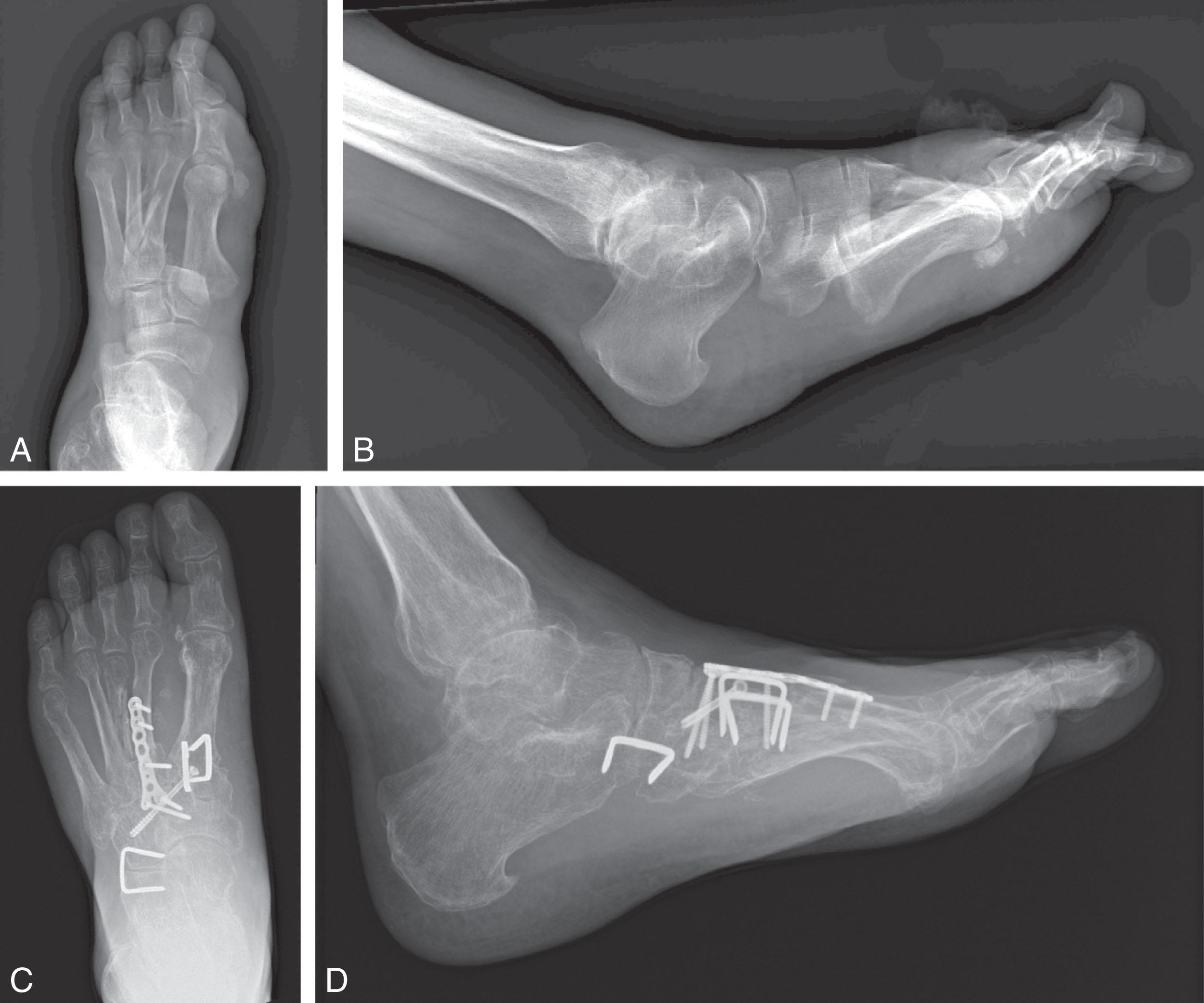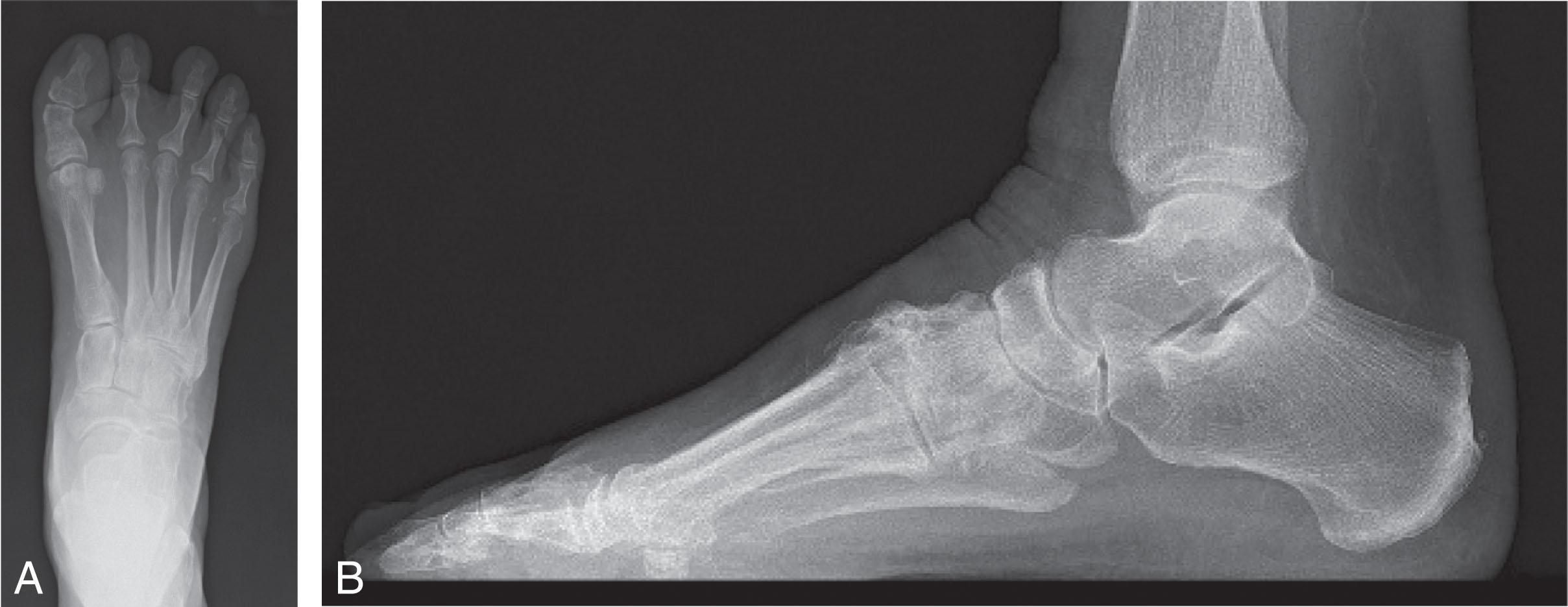Physical Address
304 North Cardinal St.
Dorchester Center, MA 02124
Midfoot arthritis is a common source of foot pain and deformity. There are numerous underlying etiologies resulting in arthritis of the midfoot of which posttraumatic arthritis is the most common. Nonoperative treatment of midfoot arthritis can be effective. If pain is refractory to nonoperative management or deformity worsens, surgical treatment is often sought. Surgical options for midfoot arthritis are mainly limited to various midfoot arthrodeses and in rare cases cheilectomy to remove offending osteophytes.
In order to review treatment options, it is necessary to review the biomechanics of the midfoot. Traditionally, the midfoot has been divided into three columns: the medial, middle, and lateral columns. The medial column consists of the first metatarsal and medial cuneiform. The middle column is composed of the second and third metatarsals along with the middle and intermediate cuneiforms. The lateral column consists of the fourth and fifth metatarsal and the cuboid. These three columns are generally referred to as the Lisfranc complex. The medial and middle columns are particularly stable, due to stout ligamentous connections. There are ligaments found dorsal, plantar, as well as interosseus. The plantar ligament, particularly from the medial cuneiform to the base of the second and third metatarsals, is named the Lisfranc ligament.
The medial and middle columns offer limited motion, whereas the lateral column has the most mobility, allowing for balance on uneven terrain as well as accommodation during the stance phase of the gait cycle. There can be approximately 20 degrees of motion in dorsiflexion/plantarflexion at the fourth and fifth metatarsal articulation with the cuboid. In contradistinction to this, there are less than four degrees of sagittal plane motion in the middle column. The medial column is further stabilized by the planar fascia through the windlass mechanism.
While the hindfoot is responsible for inversion and eversion of the foot during gait, the midfoot is tasked with modulating forward propulsion of these forces.
The positioning of the hindfoot plays a large role in force transmission and motion of the midfoot complex. When the hindfoot is inverted, the midfoot joints become locked, essentially eliminating all motion in the tarsometatarsal complex. Conversely, when the hindfoot is everted, the midfoot complex essentially unlocks, allowing for motion (see Chapter 1 ). This is seen during gait, when the hindfoot everts during heel strike. This allows for maximal motion of the midtarsal joints and the potential for foot accommodation throughout the midfoot. During toe-off, the calcaneus and hindfoot move to an inverted position. By locking the midfoot, there is resultant stability through the tarsal-metatarsal joints.
There are a variety of etiologies for midfoot arthritis, including posttraumatic, inflammatory, osteoarthritis, and neuropathic arthritis. It is thought that posttraumatic degeneration is the most common source of midfoot arthritis. The majority of posttraumatic arthritis comes from Lisfranc fracture or dislocations and their variants ( Fig. 26-1 ). For Lisfranc injuries, the ability to restore the anatomy of the articular surface and minimize future instability can reduce the risk of development of arthritis (see Chapter 47 ). Even so, the articular damage at the time of the injury seems to be a major factor in posttraumatic arthritis. Posttraumatic midfoot arthritis is the most common complication after a Lisfranc injury. There have been a plethora of authors advocating for primary arthrodesis of high-energy tarsometatarsal joint injuries to avoid the later, but potentially inevitable, need for subsequent arthrodesis.

More proximal injuries, including to the navicular, cuboid, and Chopart joints, seem to have an influence on the development of posttraumatic arthritis. This is likely due to the altered biomechanics and loading of the tarsometatarsal joints. Patients with midfoot injuries to both the Chopart and Lisfranc joints have a higher incidence of posttraumatic arthritis and lower satisfaction scores compared to patients with isolated Lisfranc or isolated Chopart injuries.
Another etiology of midfoot arthritis is osteoarthritis ( Fig. 26-2 ). This is often related to overall mechanical alignment, which leads to abnormal wearing and ultimately degeneration of the midfoot. For example, midfoot arthritis can be seen in patients with adult acquired flatfoot deformity. The valgus deformity at the hindfoot can lead to abduction through the midfoot, which alters the biomechanical loading. The loss of the motion that can occur through the hindfoot also leads to the inability to lock and unlock the midtarsal joints that normally occur during ambulation and weight bearing. There is some evidence that suggests that pes planus alignment is correlated with hallux valgus deformity, suggesting that chronic pes planus alignment can overload and lead to instability of the first tarsometatarsal joint.

Inflammatory arthritides are another instigator of midfoot arthritis. While some of these diseases, including rheumatoid arthritis, can substantially affect the hindfoot and talonavicular joint, the inflammation and pannus formation does not spare the midfoot. While this etiology does not often result in deformity, the subsequent loss of motion and articular surface degeneration can be very symptomatic and disabling. Other times, the pain gradually subsides as inflammatory arthritides have the relative unique ability to progress to autofusion. Another inflammatory condition that deserves mention is gout. Although gout most commonly affects the first metatarsalphalangeal joint, the inflammatory changes are also commonly seen at the tarsometatarsal joints as well.
An often unrecognized or misdiagnosed cause of arthritis at the midfoot comes from neuropathic collapse and destruction. Most commonly, this is seen with Charcot neuroarthropathy stemming from long-standing diabetes. While Charcot changes can occur throughout the foot and ankle, the midfoot is the most common location for this degeneration to occur. As Charcot progresses through its phases, it can result in substantial bone loss and subsequent deformity through the midfoot. The classic appearance after these changes is the rocker-bottom foot, which leaves patients at risk for ulceration and infection. Patients with these changes often require different management altogether. The primary goal is to maintain a plantigrade foot, free of ulceration or infection. Due to the changes that occur, this often requires bone resection and augmented fixation (see Chapter 32 ).
Although the diagnosis of midfoot arthritis is often confirmed by radiographic evaluation, the physical examination of these patients is essential. It is important to inspect the skin for prior incisions and their locations. As posttraumatic arthritis is the most common etiology, prior scars may often dictate the surgical approach if treating the arthritis operatively. Osteophytes over the midtarsal joints can also be seen upon inspection.
Palpation of the midfoot joints is an essential aspect of the physical examination. By their relatively subcutaneous nature, each individual tarsometatarsal joint can be palpated. Pain over a specific joint can be helpful for determining which joints may need to be treated if surgery is undertaken. The presence of osteophytes should also be determined. There are times that dorsal osteophytes may be more symptomatic than the underlying degenerative changes. Furthermore, dorsal osteophytes, particularly over the second or third tarsometatarsal joint, may cause irritation of the deep peroneal nerve. These dorsal osteophytes, in combination with dorsal pressure from shoewear, can be a cause of anterior tarsal tunnel syndrome.
It is also essential to perform a thorough neurovascular examination. The dorsalis pedis artery runs with the deep peroneal nerve dorsally on the foot at this level. It is helpful to know the location of this artery if surgery is undertaken. Furthermore, nonpalpable pulses would be an indication for further vascular examination, possibly including duplex arterial ultrasound, to ensure a patient had the prerequisite vascular supply to heal from a potential operation. Sensation testing should be performed with a Semmes-Weinstein Monofilament as well. Considering that some cases of midfoot arthritis arise from Charcot neuroarthropathy, the absence of sensation on the plantar aspect of the foot should be known.
When considering midfoot arthritis in the differential diagnosis of foot pain, it is essential to obtain radiographs. These should include anteroposterior, oblique, and lateral views.
It is vital that these radiographs are taken weight bearing. Non–weight-bearing radiographs do not adequately demonstrate any deformity that may occur with this arthritis. This is particularly important when evaluating the first tarsometatarsal joint. Deformity at this joint commonly occurs on the sagittal plane, and instability can be seen by plantar gapping.
There is a role for advanced imaging, including both MRI and CT scans. Both of these imaging modalities can evaluate each individual joint better than plain radiographs. This level of detail may be beneficial in determining which specific joints need to be treated surgically. Furthermore, these imaging studies are useful when determining whether the dorsal osteophytes alone or the entire joint should be treated surgically as well. Weight-bearing CT scan, a relatively new modality, allows detailed views of the interrelationships of the small joints of the midfoot during physiological loading and may show previously undetected intersegment instability.
Nonoperative treatment for midfoot arthritis should be focused on both the inflammatory and the biomechanical aspects of the disease. Nonsteroidal antiinflammatory drugs (NSAIDs) are a mainstay of treatment for these symptoms. While NSAIDs can offer substantial pain relief, their use must be monitored. These medications can cause adverse side effects, particularly in older patients. There is a role for topical NSAIDs or even capsaicin, which tend to have less systemic side effects and systemic absorption than their oral forms. Furthermore, topical are effective in the midfoot due to the minimal soft tissue between the skin surface and affected joints.
In addition to medical treatments, shoewear modifications or orthotic use should be considered. Decreasing motion through the midfoot can decrease the force through the tarsometatarsal (TMT) joints. This can be accomplished through a stiff-soled shoe or a carbon graphite shoe insert. A midfoot rocker on the plantar aspect of the shoe can also unload stress from the midfoot. The may be found on some over-the-counter shoe models or added to an existing shoe. Custom orthotics can also be utilized for nonoperative treatment. Stiff inserts, such as full-length carbon fiber inserts, work to decrease the medial midfoot contact time and the average plantar pressures during ambulation. Even more restrictive braces, such as an ankle foot orthosis (AFO), can decrease pressure on the medial midfoot as well.
Intraarticular injections are another tool in the nonoperative care of midfoot arthritis. Steroid injections have both diagnostic and therapeutic benefits. When used with local anesthesia, such as lidocaine, a specific tarsometatarsal can be injected to determine the amount of improvement. If symptoms are partially resolved, it would suggest that this joint is contributing to the overall symptoms. This technique is not completely reliable, as some of the medication can extravasate into adjacent joints, decreasing the effectiveness of the diagnostic injection, and many midfoot join capsules are in continuity with their neighboring joints. It is possible to inject the first tarsometatarsal joint by palpating surrounding landmarks to determine its precise location. It is more difficult, however, to inject the second TMT joint utilizing palpation. Fluoroscopy or ultrasound can greatly increase the accuracy of the joint injection.
Become a Clinical Tree membership for Full access and enjoy Unlimited articles
If you are a member. Log in here